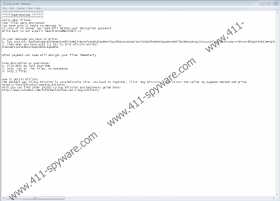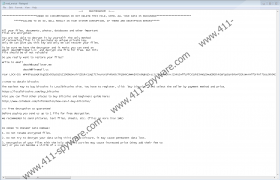DeathRansom Ransomware Removal Guide
From what we have learned about DeathRansom Ransomware, it looks like it was programmed to encrypt files and add the .wctc extension at the end of each enciphered file’s name. Nonetheless, we discovered that there might be a few versions of the threat and that they may all work differently. If you want to learn about their differences as well as how this infection could sneak onto your system, you could read the rest of this article. If the malware is on your device and you want to get rid of it manually, you could use our deletion instructions provided below. Of course, if the process looks difficult and you do not think you can eliminate DeathRansom Ransomware manually, you could use a reliable security tool instead.
One of the biggest questions after detecting DeathRansom Ransomware on your system might be how it entered your computer. The truth is there are a couple of ways such a malicious application might sneak onto a device. For instance, a user could be tricked into launching an infected email attachment. Emails from hackers may look as if they come from reputable companies. Also, such emails might try to raise a victim’s curiosity by making malicious launchers look like pictures, text documents, and so on. Therefore, users who want to protect their system should never open attachments received from someone they do not know or files received unexpectedly, even if they seem to originate from reputable sources.
The other popular way to distribute malicious applications, such as DeathRansom Ransomware is to disguise their launchers as software installers, updates, and other files that could be distributed via torrent sites and similar sources. Thus, we highly recommend downloading installers from reputable websites only. As for updates, it is always safer to allow your computer to download them for you. What we can suggest for users who may want to open files received from doubtful sources is to scan them with a reliable security tool. Whether a file from the Internet looks like a picture, a document, or an installer of a legitimate program, you should never let your guard down and take scan it with a chosen antimalware tool first.
After entering a system, the malware may create a Registry entry in the HKCU\SOFTWARE location. The first sample of DeathRansom Ransomware that we found did not encipher any files. Yet it still displayed a text document saying that all files were encrypted and that the only way to get them back is to pay for their decryption. The second version that we encounter encrypted data available on an infected device, but it did not add the .wctc extension. Also, the second version dropped a ransom note with a similar message; it should be called read_me.txt too. These messages might claim that hackers can provide free decryption services to prove that they have decryption tools. It is essential to understand that having the means for deciphering your files does not mean they will be delivered to you. What we are trying to say is that the malware’s developers could trick you, no matter what they promise, and so you should consider their offer carefully.
Naturally, if you receive the version that does not encrypt files, you should not pay any attention to the malware’s ransom notes. In fact, we recommend the same even if your data becomes enciphered if you do not want to pay a ransom. It is worth checking if you have any backup copies that you could replace your encrypted files with, in which case you would no longer need to decrypt them. Of course, to be safe, we advise deleting DeathRansom Ransomware before transferring backup copies on your computer. You could erase it manually if you follow the deletion instructions located below. Users who do not think they are experienced enough to eliminate DeathRansom Ransomware manually could get a reputable antimalware tool that would remove the threat for them.
Get rid of DeathRansom Ransomware
- Tap Ctrl+Alt+Delete.
- Pick Task Manager.
- Select the Processes tab.
- Look for a process associated with the malware.
- Select the process and click End Task.
- Leave Task Manager.
- Tap Win+E.
- Go to these locations:
%TEMP%
%USERPROFILE%\Downloads
%USERPROFILE%\Desktop - Find the malicious file opened before the system got infected, right-click it, and select Delete.
- Search for files named read_me.txt, right-click them and select Delete.
- Close File Explorer.
- Tap Win+R.
- Type Regedit and click Enter.
- Go to: HKCU\SOFTWARE
- Identify the malware’s created key, e.g., Wacatac, right-click it, and press Delete.
- Close Registry Editor.
- Empty Recycle Bin.
- Restart the computer.
DeathRansom Ransomware Screenshots:



